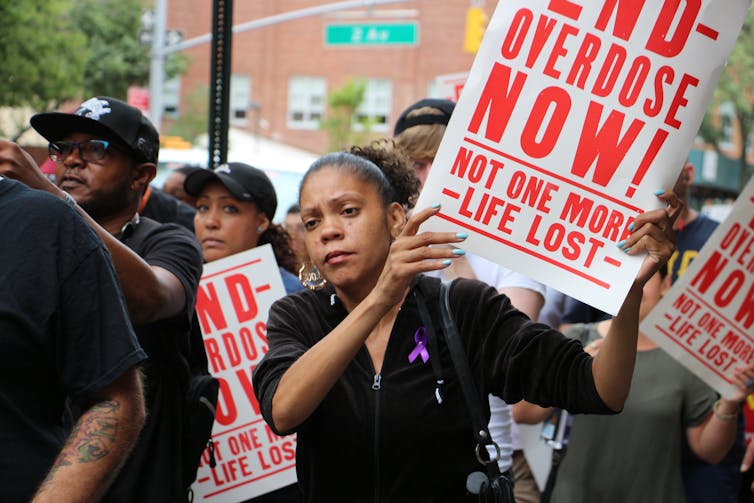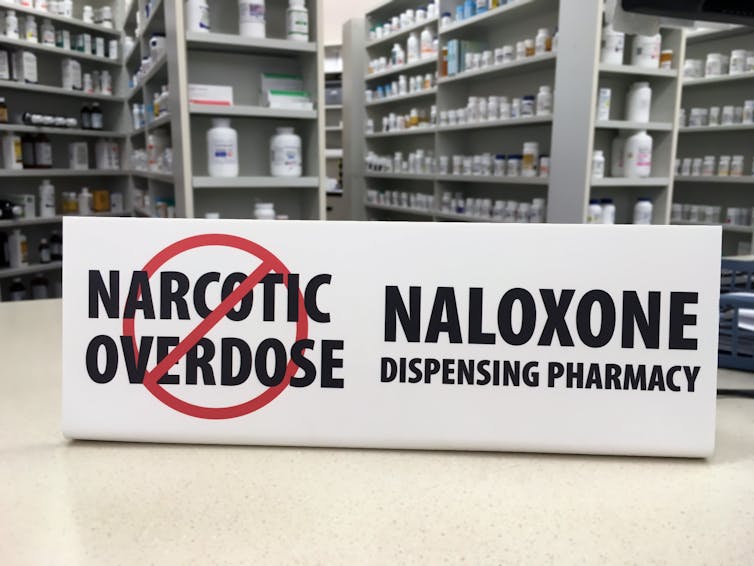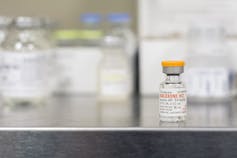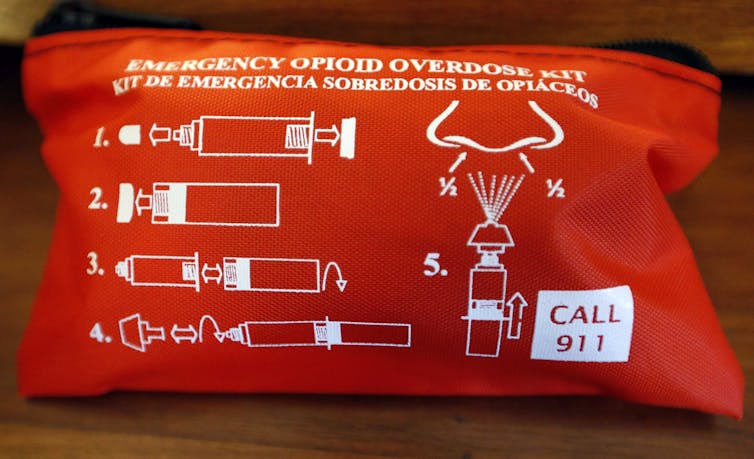Pharmacists could be front-line fighters in battle against opioid epidemic
- Written by Victoria Tutag Lehr, Professor of Pharmacy, Wayne State University
When you stop at your local pharmacy to pick up a toothbrush or an antacid, soon you may also be able to buy an over-the-counter drug to reverse an opioid overdose. The lifesaving drug, naloxone, currently requires a prescription, but it may become available as an over-the-counter purchase in 2020.
Despite the national decrease in opioid prescriptions[1] since 2012, the opioid crisis[2] continues. Access to prescription opioids have decreased due to stricter legislation[3], insurance regulations and the Centers for Disease Control Guideline for Prescribing Opioids for Chronic Pain. At the same time, the use of heroin and illegally manufactured synthetic opioids, such as fentanyl and counterfeit prescription opioids, has escalated[4].
In addition, nearly 80% of opioid overdoses[5] involve multiple substances, compounding the risk of a fatal overdose. This reinforces the need for widespread, convenient naloxone access accompanied by training on how to administer[6] this reversal drug.
As a professor of pharmacy[7] and pharmacist, I believe that many more pharmacists can be engaged in providing naloxone for their patients.
 Communities demand attention for the damage caused by the opioid crisis.
Shutterstock.com/SCOOTERCASTER[8]
Communities demand attention for the damage caused by the opioid crisis.
Shutterstock.com/SCOOTERCASTER[8]
Essential medication to save a life
An opioid overdose can depress a person’s respiratory center to the point where breathing stops, resulting in death. Naloxone can reverse this effect within minutes. With minimal training, anyone can safely administer naloxone in various forms – nasal spray, auto-injector or intramuscular injection – to effectively buy more time and get medical help for someone who has overdosed.
Naloxone has been used in hospitals for more than 40 years to reverse excess sleepiness and respiratory depression from opioid anesthesia and pain medication or to treat overdoses in the emergency room. During the 1990s, naloxone use expanded into communities[9] to first responders, laypersons and, most importantly, to people who use drugs to reverse opioid overdoses.
The U.S. surgeon general issued an advisory[10] in April 2018 encouraging family, friends and individuals at risk for an opioid overdose to carry naloxone and be trained to administer it. Research shows[11] that wider access to naloxone is associated with fewer deaths. Naloxone could successfully reverse[12] every witnessed opioid overdose, but only if naloxone is in the hands of a trained bystander. The challenge has been how to get naloxone to the people who need it.
In 48 states and the District of Columbia, pharmacists are now able to dispense naloxone under a standing order that does not require a physician’s prescription, or they can directly prescribe naloxone[13]. But people may still be hesitant to ask for naloxone.
 Pharmacies may one day dispense naloxone as an over-the-counter drug.
PureRadiancePhoto/Shutterstock.com[14]
Pharmacies may one day dispense naloxone as an over-the-counter drug.
PureRadiancePhoto/Shutterstock.com[14]
Why community pharmacists are key
Opioid use disorder[15] is a chronic, relapsing, lifelong condition. Managing opioid use disorder requires sustained treatment and support, similar to other chronic conditions, such as diabetes and heart disease. But opioid use disorder often carries a social stigma, which can make people hesitant about seeking help through traditional health care channels.
People may be afraid to request a prescription for naloxone because they may be accused of misusing drugs. Others may not know how or where to obtain naloxone, particularly if they don’t have a regular health care provider. People who use drugs report feeling stigmatized[16], while providers including pharmacists may be uncomfortable[17] starting a conversation with patients about the importance of carrying naloxone.
Yet the greater the access to naloxone, the more likely this lifesaving drug will be administered to reverse an overdose. I believe that pharmacists in the community are ideally positioned as a local resource to obtain naloxone. Community pharmacies have evolved into neighborhood health centers[18] where individuals can access a variety of services outside a traditional clinical setting including immunizations, health screenings and lab monitoring.
 Vial of naloxone.
PureRadiancePhoto/Shutterstock.com[19]
Vial of naloxone.
PureRadiancePhoto/Shutterstock.com[19]
Pharmacists[20] can recommend and provide naloxone, opioid education and overdose prevention information to high-risk individuals and their support network. Pharmacists can make their pharmacy a safe and nonjudgmental resource, where people obtain and learn to administer naloxone, seek self-care advice and reduce harm from drug use, including clean needles and syringes. And pharmacists are well positioned to provide connections to local programs for recovery and support. They can make referrals to supportive health care providers and provide “whole person” care for vulnerable individuals.
Federal support to halt deadly overdoses
The U.S. Department of Health and Human Services recognizes the importance of addressing opioid use disorder and the opioid crisis with a 5-point strategy[21]. This includes better access to opioid use disorder treatment, research funding, improved pain management and expanded naloxone availability in health care and community settings.
 Emergency overdose kit.
AP Photo/Jim Cole[22]
Emergency overdose kit.
AP Photo/Jim Cole[22]
While naloxone is not yet available for purchase over the counter, the U.S. Food and Drug Administration supports this simple access and has developed a “drug facts naloxone label” with pictures making it easy for anyone to effectively administer the correct dose. Manufacturers can apply for over-the-counter status, and naloxone is expected to become available as an over-the-counter drug this year[23]. The availability to purchase naloxone without a prescription and over the counter can remove the perceived stigma of having to request it from a health care provider or pharmacist.
Naloxone alone will not mitigate the opioid crisis. Yet the ability to reverse a fatal overdose – having someone nearby who carries and can administer naloxone – allows the survivor another chance to enter treatment that addresses[24] the social, structural, genetic, behavioral and individual factors of opioid use disorder. Pharmacists have an important role in helping to remove the stigma associated with requesting and carrying naloxone by openly discussing its benefits and making naloxone available to all patients.
[Insight, in your inbox each day. You can get it with The Conversation’s email newsletter[25].]
References
- ^ national decrease in opioid prescriptions (www.cdc.gov)
- ^ opioid crisis (www.cdc.gov)
- ^ stricter legislation (doi.org)
- ^ escalated (www.cdc.gov)
- ^ nearly 80% of opioid overdoses (doi.org)
- ^ training on how to administer (doi.org)
- ^ professor of pharmacy (cphs.wayne.edu)
- ^ Shutterstock.com/SCOOTERCASTER (www.shutterstock.com)
- ^ into communities (www.drugabuse.gov)
- ^ advisory (www.surgeongeneral.gov)
- ^ Research shows (doi.org)
- ^ successfully reverse (doi.org)
- ^ directly prescribe naloxone (ldi.upenn.edu)
- ^ PureRadiancePhoto/Shutterstock.com (www.shutterstock.com)
- ^ Opioid use disorder (www.psychiatry.org)
- ^ feeling stigmatized (doi.org)
- ^ providers including pharmacists may be uncomfortable (www.ncbi.nlm.nih.gov)
- ^ neighborhood health centers (www.michiganpharmacists.org)
- ^ PureRadiancePhoto/Shutterstock.com (www.Shutterstock.com)
- ^ Pharmacists (doi.org)
- ^ 5-point strategy (www.hhs.gov)
- ^ AP Photo/Jim Cole (www.apimages.com)
- ^ this year (doi.org)
- ^ treatment that addresses (doi.org)
- ^ You can get it with The Conversation’s email newsletter (theconversation.com)
Authors: Victoria Tutag Lehr, Professor of Pharmacy, Wayne State University


